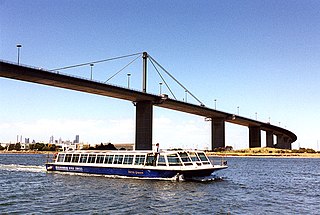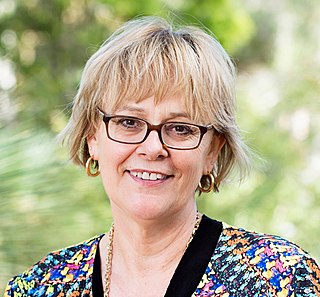
The West Gate Bridge is a steel, box girder, cable-stayed bridge in Melbourne, Victoria, Australia, spanning the Yarra River just north of its mouth into Port Phillip. It carries the West Gate Freeway and is a vital link between the inner city (CBD) and Melbourne's western suburbs, with the industrial suburbs in the west, and with the city of Geelong 80 kilometres (50 mi) to the south-west. It is part of one of the busiest road corridors in Australia. The high span bridge was built to allow large cargo ships to access the docks in the Yarra River.

Risk compensation is a theory which suggests that people typically adjust their behavior in response to perceived levels of risk, becoming more careful where they sense greater risk and less careful if they feel more protected. Although usually small in comparison to the fundamental benefits of safety interventions, it may result in a lower net benefit than expected or even higher risks.

Safety in numbers is the hypothesis that, by being part of a large physical group or mass, an individual is less likely to be the victim of a mishap, accident, attack, or other bad event. Some related theories also argue that mass behaviour can reduce accident risks, such as in traffic safety – in this case, the safety effect creates an actual reduction of danger, rather than just a redistribution over a larger group.
Seat belt legislation requires the fitting of seat belts to motor vehicles and the wearing of seat belts by motor vehicle occupants to be mandatory. Laws requiring the fitting of seat belts to cars have in some cases been followed by laws mandating their use, with the effect that thousands of deaths on the road have been prevented. Different laws apply in different countries to the wearing of seat belts.

Road toll is the term used in New Zealand and Australia for the number of deaths caused annually by road accidents.

Motorcycle safety is the study of the risks and dangers of motorcycling, and the approaches to mitigate that risk, focusing on motorcycle design, road design and traffic rules, rider training, and the cultural attitudes of motorcyclists and other road users.

Bicycle safety is the use of road traffic safety practices to reduce risk associated with cycling. Risk can be defined as the number of incidents occurring for a given amount of cycling. Some of this subject matter is hotly debated: for example, which types of cycling environment or cycling infrastructure is safest for cyclists. The merits of obeying the traffic laws and using bicycle lighting at night are less controversial. Wearing a bicycle helmet may reduce the chance of head injury in the event of a crash.

Monash University, Parkville campus is a campus of Monash University, located in Parkville, Victoria, Australia. It is home to the Faculty of Pharmacy and Pharmaceutical Sciences. Founded in 1881 and previously known as the Victorian College of Pharmacy, the Faculty is the oldest school of pharmacy in Australia. A major centre of research and teaching, it is internationally regarded for its research in drug target biology and discovery, medicinal chemistry, drug development, formulation science, and medicine use and safety, including the discovery and development of the world's first successful anti-influenza drug, Relenza. In international rankings, it is ranked as the number one school of pharmacy and pharmacology in Australia and worldwide.
Monash University Faculty of Law, or Monash Law School, is the law school of Monash University. Founded in 1963, it is based in Melbourne, Victoria and has campuses in Malaysia and Italy. It is consistently ranked as one of the top law schools in Australia and globally, and entry to its Bachelor of Laws (LLB) programme is highly competitive.
The Monash University Accident Research Centre (MUARC) is a research institute in the injury prevention field. The centre is located at the Clayton Campus of Monash University in Victoria, Australia.
The Hell Ride, also known as the Hell Dog, is an informal group bicycle training ride that follows the coastline of Port Phillip Bay through the south–eastern suburbs of Melbourne, Victoria, Australia. It meets at 7am on Saturdays at the Black Rock clock tower, Black Rock and heads south towards Mount Eliza along Beach Road.

The Hurt Report, officially Motorcycle Accident Cause Factors and Identification of Countermeasures, was a motorcycle safety study conducted in the United States, initiated in 1976 and published in 1981. The report is named after its primary author, Professor Harry Hurt.
Intelligent speed assistance (ISA), or intelligent speed adaptation, also known as alerting, and intelligent authority, is any system that ensures that vehicle speed does not exceed a safe or legally enforced speed. In case of potential speeding, the driver can be alerted or the speed reduced automatically.
Monash University is an Australian university located in Melbourne, Australia with some international campuses. It was established by an Act of the State Parliament of Victoria in 1958 as a result of the Murray Report which was commissioned in 1957 by the then Prime Minister Sir Robert Menzies to establish the second university in the state of Victoria.

A traffic collision, also called a motor vehicle collision, car accident or car crash, occurs when a vehicle collides with another vehicle, pedestrian, animal, road debris, or other stationary obstruction, such as a tree, pole or building. Traffic collisions often result in injury, disability, death, and property damage as well as financial costs to both society and the individuals involved. Road transport is the most dangerous situation people deal with on a daily basis, but casualty figures from such incidents attract less media attention than other, less frequent types of tragedy.

Speed limits are enforced on most public roadways by authorities, with the purpose to improve driver compliance with speed limits. Methods used include roadside speed traps set up and operated by the police and automated roadside 'speed camera' systems, which may incorporate the use of an automatic number plate recognition system. Traditionally, police officers used stopwatches to measure the time taken for a vehicle to cover a known distance. More recently, radar guns and automated in-vehicle systems have come into use.

Australia was the first country to make wearing bicycle helmets mandatory. The majority of early statistical data regarding the effectiveness of bicycle helmets originated from Australia. Their efficacy is still a matter of debate.
Jennie Louise Ponsford is an Australian neuroscience researcher at Monash University, Victoria who has a special interest in Traumatic Brain Injury (TBI). Jennie is a clinical neuropsychologist, whose work is focused on developing a deeper understanding of the negative consequences of TBI, particularly those related to fatigue, sleep disturbance, attentional problems, mood and behavioural disturbances, and the development of rehabilitation interventions to improve long term recovery and quality of life in individuals with TBI.

Caroline Finch AO is an Australian sports injury epidemiologist and sports injury prevention researcher. Her research has been adopted and used to directly inform safety policy by Government Departments of Sport and Health, health promotion and injury prevention agencies, and peak sports bodies both within Australia and internationally. Her injury prevention research has been applied to falls in older people, road safety, workplace safety and injuries in children.
The National Coronial Information System (NCIS) is a national database of coronial information on every death reported by a Coroner in Australia from July 2000 and New Zealand from July 2007. It assists coroners, their staff, public sector agencies, researchers and other agencies in obtaining coronial data to inform death and injury prevention activities.












